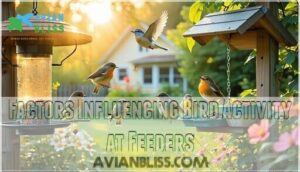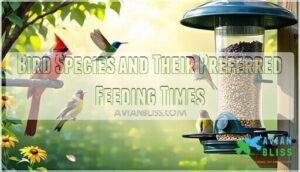This site is supported by our readers. We may earn a commission, at no cost to you, if you purchase through links.

These peak hours align with birds’ natural energy needs, when they’re replenishing calories lost overnight or preparing for evening roosting.
Different species have unique feeding patterns, but most wild birds prefer these dawn and dusk windows to minimize predation risks while maximizing nutritional intake.
Morning feeding helps birds recover from nighttime energy expenditure, while afternoon visits help them stock up before nightfall.
Pro tip: If you want consistent feeder traffic, place your feeders in quiet, protected areas with nearby tree cover.
Table Of Contents
- Key Takeaways
- Peak Feeding Times for Birds at Feeders
- Factors Influencing Bird Activity at Feeders
- Bird Species and Their Preferred Feeding Times
- Balancing Energy Needs and Predation Risks
- Optimizing Feeder Setup for Peak Activity
- Frequently Asked Questions (FAQs)
- What time of day are birds most active at feeders?
- Do birds feed more in early mornings or late afternoons?
- When do birds feed at bird feeders?
- When is the best time to feed birds?
- What time do birds eat?
- When are birds most active?
- Do birds feed more in the early morning or late afternoon?
- What time of Day should I watch my bird feeder?
- When do diurnal birds eat?
- What time of day are birds more active?
- Conclusion
Key Takeaways
- You’ll see the most bird feeder activity during two prime times: early morning (7-9 AM) and late afternoon (4-6 PM), when birds are replenishing energy lost overnight or preparing for evening roosting.
- Different bird species have unique feeding patterns, but most wild birds prefer dawn and dusk windows to minimize predation risks while maximizing nutritional intake.
- Morning feeding helps birds recover from nighttime energy expenditure, while afternoon visits allow them to stock up on calories before nightfall.
- If you want consistent feeder traffic, place your feeders in quiet, protected areas with nearby tree cover that provide safety and easy access for your feathered visitors.
Peak Feeding Times for Birds at Feeders
You’ve probably noticed birds buzzing around your feeders at certain times of the day, but have you ever wondered when they’re most active?
Understanding peak feeding times can help you maximize your bird-watching experience and help your feathered friends get the nourishment they need throughout the day.
Early Morning Surge in Feeder Activity
As the sun peeks over the horizon, a vibrant dawn chorus signals the start of morning bird feeding.
Dawn breaks, igniting a symphony of chirps and wings as hungry birds emerge to feast on the morning’s first light.
Your bird feeder becomes a bustling breakfast spot, with cardinal arrivals marking peak activity.
Overnight roosting leaves birds hungry, driving them to seek quick energy replenishment in the first rays of morning sunlight.
Strategic feeder placement guarantees maximum early morning bird activity.
Late Afternoon Feeding Patterns
As twilight beckons, bird feeders transform into bustling social hubs.
Late afternoon sparks a feeding frenzy where diverse species converge.
Your strategic approach matters:
- Position feeders near protective shrubs
- Offer high-energy sunflower seeds
- Anticipate pre-roosting feeding rushes
- Minimize nearby predator threats
- Observe species competition dynamics
Evening energy peaks, revealing intricate bird feeding behaviors during this critical window.
Midday Lull in Bird Visits
As the morning buzz winds down, your bird feeder enters a quiet intermission.
Midday brings a natural pause in bird activity, driven by heat avoidance and energy conservation.
Birds seek shade, retreat to nesting areas, and minimize territorial conflicts. They’re not disappearing—they’re strategically resting.
This lull offers you a unique window to observe subtle behaviors: preening, quiet wing stretches, or delicate nest maintenance.
Keep water fresh nearby, and you might catch these intimate midday moments of avian life.
Seasonal Variations in Feeding Times
The rhythm of bird feeding transforms dramatically with each passing season, turning your backyard into a dynamic ecosystem of avian activity.
As nature’s calendar shifts, so do the dining habits of our feathered friends.
- Winter demands early morning energy restoration, with birds frantically refueling after cold nights
- Spring migration brings unpredictable feeding windows as travelers seek critical nutrition
- Summer sees parent birds constantly shuttling between nest and feeder to nourish growing chicks
During winter, feeders become survival stations where birds compete for precious calories.
The spring migration period turns your yard into a bustling rest stop, with birds dropping in at irregular intervals to replenish their energy reserves.
Summertime introduces a new dynamic, with parent birds making frequent visits to support their hungry offspring.
Weather impacts these patterns considerably, driving birds to adapt their feeding habits to guarantee survival across changing seasonal landscapes.
Your feeder becomes more than just a food source—it’s a lifeline through nature’s most challenging shifts.
Nighttime Feeder Activity (or Lack Thereof)
While daytime brings bird feeder buzz, nighttime tells a different story.
Most garden birds retreat to safety, leaving feeders quiet as a mouse.
Nocturnal visitors like owls skip seed buffets, preferring live prey hunting instead.
Want a peek into night’s avian world? Set up motion sensor cameras near your feeders to catch rare owl encounters or unexpected rodent attraction.
Artificial lighting might spark occasional nighttime activity, but don’t expect a feathered festival.
Your bird feeder becomes a silent stage after sunset, with only the occasional nocturnal bird breaking the stillness.
Adaptations for nighttime foraging are key to these birds’ survival.
Nature’s night shift is subtle and selective.
Factors Influencing Bird Activity at Feeders
Ever wondered why some birds flock to your feeder at certain times while others seem to vanish?
Understanding the key factors that influence bird activity can help you transform your backyard into a bustling avian hotspot throughout the day.
Bird Species Preferences
Not all birds feast at the same buffet! Seed preferences reveal fascinating differences among our feathered friends.
Some key insights for bird enthusiasts:
- Hulled sunflower seeds attract 88.8% of bird species
- Platform feeders welcome the most diverse crowd
- Blue jays and titmice have unique dietary needs
Discover which backyard birds call your feeder home by understanding their distinct feeding habits.
Each species brings its own personality to the bird-watching party, turning your outdoor space into a dynamic wildlife hotspot.
Weather and Seasonal Changes
When your feathered friends face nature’s mood swings, their feeding patterns transform dramatically.
Winter’s chilly breath drives birds to your feeders more frequently, turning them into critical energy stations during harsh conditions.
Rainy days might slow down traffic, but migration peaks bring unexpected visitors seeking quick refueling stops.
Summer lulls contrast sharply with these bustling periods, where seasonal diets and weather shifts dictate bird feeder activity.
Your backyard becomes a dynamic ecosystem, responding to temperature changes, storm fronts, and the rhythmic pulse of avian survival strategies. Understanding migration’s environmental cues helps explain these patterns.
Cold Weather
Rain/Storms
Temperature Swings
Seasonal Shifts
Feeding Time Patterns
Your bird feeder becomes a bustling wildlife diner when you understand daily rhythms of avian visitors.
Peak bird feeding times shift like clockwork, with chickadees and nuthatches launching early morning raids, while finches arrive in cheerful flocks during mid-morning hours.
Woodpeckers and jays typically dominate afternoon sunflower seed sessions.
By tracking consistent patterns and seasonal shifts, you’ll transform your backyard into a premier bird feeding hotspot.
Knowing peak hours helps you strategically time refills, maximizing bird activity and creating an irresistible dining experience for your feathered friends.
Bird Species and Their Preferred Feeding Times
You’ll be amazed to discover that different bird species have unique feeding times throughout the day, turning your backyard into a dynamic dining hall from dawn to dusk.
By understanding these feeding patterns, you’ll transform your bird feeder into a bustling hotspot that attracts a diverse array of feathered visitors at precisely the right moments. Complete concepts and separate lines are key.
Transform your backyard into a dynamic avian dining hall, where every moment reveals nature’s vibrant feeding symphony.
Early Birds: Dawn Feeders
The quiet sunrise heralds a symphony of first arrivals at your backyard feeder.
Dawn species like cardinals and chickadees emerge with remarkable precision, ready to refuel after a long night’s rest:
- Northern cardinals flash brilliant red against morning shadows
- Chickadees dart playfully between seed clusters
- Robins hop expectantly across dewy ground
These early risers transform your garden into a bustling breakfast station, celebrating morning energy with cheerful chirps and swift, purposeful movements during peak bird feeding times.
Midday Feeder Visitors
After sunrise’s bustling dawn feeders, midday visitors play a different game.
When the sun blazes overhead, some species turn feeding into an art form:
- House sparrows seek shady retreats
- Doves claim feeders with calm persistence
- Finches transform midday into a lively feeding spectacle
Strategic water sources and well-placed shade can transform your backyard into a midday bird sanctuary during heat’s peak hours.
Dusk-loving Bird Species
Ever wondered which feathered friends make a final feast as daylight dims? Crepuscular birds like Mourning Doves and Northern Cardinals transform your backyard into a twilight buffet, grabbing last-minute calories before nightfall.
| Species | Dusk Activity | Feeding Style |
|---|---|---|
| Mourning Doves | High | Ground Feeders |
| Northern Cardinals | Moderate | Tray Feeders |
| Common Nighthawks | Low | Aerial Hunters |
| Robins | Moderate | Mixed Terrain |
| Sparrows | High | Varied Locations |
These evening specialists showcase remarkable evening bird feeding patterns, turning dusk into a brief but vibrant dining experience.
Nocturnal Birds at Feeders
Most nocturnal birds rarely visit feeders, but their nighttime world brims with fascinating hunting strategies.
Hidden hunters like owls navigate darkness using incredible adaptations:
- Razor-sharp night vision pierces shadowy landscapes
- Silent wing feathers glide without rustling
- Acute hearing tracks smallest prey movements
- Camouflage blends seamlessly with moonlit branches
Motion cameras reveal unexpected nighttime visitors like raccoons and flying squirrels prowling around birdbaths and seed stations.
Owls, nighthawks, and nightjars are examples of nocturnal bird species.
Year-round Vs. Seasonal Feeder Birds
Welcoming resident species like chickadees and nuthatches guarantees steady bird feeder hours year-round, while migratory visitors bring seasonal excitement during breeding and winter periods.
By understanding bird activity patterns and adjusting your feeding schedule, you’ll attract diverse feathered friends.
Time your seed refills strategically, and watch as different species dance through your backyard at various times of day. Adjusting your feeding schedule
Balancing Energy Needs and Predation Risks
When you’re observing birds at your feeders, you’ll quickly realize they’re balancing a complex dance between fueling up and staying safe from predators.
Understanding how birds navigate their energy needs while avoiding potential threats can help you create a more welcoming and secure feeding environment for your feathered visitors.
Morning Feeding as Energy Replenishment
In the early light of dawn, birds wake up to a key energy challenge after long hours of overnight energy loss.
Their morning metabolism kicks into high gear, making first feeder visits absolutely essential for survival.
These early bird diets are more than just a meal—they’re a lifeline.
- Replenish key calories lost during nighttime
- Target high-energy seed varieties
- Position feeders in clear, sunny locations
- Create a consistent morning feeding routine
- Minimize potential disturbances near feeding areas
Peak bird activity occurs when the first rays of sunlight warm the landscape, driving birds to quickly restore their depleted reserves.
Consider feeder placement strategies to maximize bird access and safety.
Sunflower and millet seeds become nutritional powerhouses, providing the rapid calorie boost needed to jump-start their day.
By understanding these dawn calorie needs, you can transform your backyard into a key refueling station for hungry, energetic birds seeking their morning breakfast.
Predator Avoidance Strategies
During peak bird activity, survival means more than just finding food—it’s about staying safe.
When birds gather at feeders, they deploy clever predator avoidance strategies that blend science and instinct.
By positioning feeders within 3.5 meters of shelter, you’ll provide critical escape routes.
Install guards or barriers that block ground predators, and guarantee clear sightlines around feeding areas.
Group feeding offers another layer of protection, with multiple birds acting as lookouts.
Birds instinctively choose locations with quick hiding spots, often near dense shrubs or trees.
Strategic feeder placement—elevated and near natural cover—lets birds monitor their surroundings while minimizing attack risks.
These tactics transform your backyard into a secure dining zone.
Impact of Daylight on Feeding Behavior
Birds’ daylight rhythms dictate their feeding strategy, transforming your backyard into a dynamic ecosystem.
As the sun’s rays stretch across the horizon, crepuscular species become most active, maneuvering between dawn and dusk with remarkable precision.
Your feeder’s placement can capitalize on these daily light cycles, maximizing bird visibility and attracting a diverse array of winged visitors.
Understanding seasonal light variations helps you predict and appreciate the intricate dance of avian feeding habits throughout the day.
Risk Assessment in Different Time Periods
Every feeding moment brings a risk-reward symphony for birds traversing daily survival. Your backyard becomes a critical arena where safety and sustenance intersect:
- Dawn predator risks test birds’ vigilance against aerial hunters
- Midday heat stress challenges energy conservation strategies
- Dusk visibility decline amplifies survival decision-making
Survival isn’t just about eating—it’s about outsmarting nature’s complex choreography of threat and nourishment.
Energy Conservation During Inactive Hours
When temperatures drop, birds enter a metabolic survival mode.
They minimize energy expenditure through clever resting strategies and strategic roosting behavior.
Consider their daily rhythm through this quick guide:
| Technique | Purpose | Energy Saved |
|---|---|---|
| Nocturnal Torpor | Reduce Body Heat | High |
| Clustered Roosting | Shared Warmth | Moderate |
| Minimizing Movement | Conserve Calories | Significant |
These adaptations help birds weather challenging conditions, ensuring they’re primed to thrive when active feeding times return.
Optimizing Feeder Setup for Peak Activity
If you want to turn your backyard into a bustling bird haven, you’ll need to master the art of strategic feeder placement and timing.
By understanding peak activity periods and optimizing your feeding station, you’ll create an irresistible buffet that attracts a diverse array of feathered visitors throughout the day.
Timing Feeder Refills for Maximum Visits
Maximize your feeder’s allure by strategically timing refills to match birds’ hungriest hours.
Here’s your quick guide to attracting more feathered friends:
- Refill early morning before peak activity
- Target late afternoon feeding windows
- Watch for weather-driven traffic spikes
- Maintain a consistent, predictable supply
- Adapt your schedule to local bird behaviors
Your bird feeding schedule becomes a beacon of hope, drawing winged visitors with a reliable, well-timed feast that keeps them coming back for more.
Placement Strategies for Different Times
Level up your bird feeder game by strategically shifting its location throughout the day.
In morning sun, place feeders where birds can easily spot their breakfast.
- Bird-proof your feeding zone by positioning near protective trees, avoiding predator-friendly bushes, and creating clear escape routes.
Consider optimal feeder placement for attracting more birds.
Seasonal adjustments keep your feathered friends coming back, turning your yard into a dynamic bird sanctuary.
Types of Feeders for Various Activity Periods
Think of bird feeders as specialty restaurants catering to different avian appetites.
Hopper feeders welcome early risers seeking hearty seeds, while platform feeders offer all-day dining for casual grazers.
Tube feeders satisfy picky eaters, and nectar feeders serve sweet sips to hummingbirds.
Suet feeders deliver protein-packed meals for energetic visitors.
Your feeder choice dramatically impacts bird activity throughout the day, from dawn’s first chirpers to dusk’s last hungry guests.
Consider exploring different feeder options for your yard.
Match your feeder design to local birds’ dining preferences! Feeder choice dramatically impacts bird activity.
Creating a 24-hour Feeding Station
Transform your backyard into a 24/7 bird cafe by designing a multi-functional feeding station. Your goal? Keep winged guests happy around the clock.
- Install soft, motion-activated lighting to support nocturnal and crepuscular species
- Use predator-deterrent feeders with strategic placement
- Offer diverse seed mixes for year-round provisioning
- Create sheltered areas for dawn and dusk feeding
- Select feeders adaptable to different bird activity patterns
This isn’t just a feeding station—it’s a complete avian hospitality experience that meets every feathered friend’s dining needs.
Monitoring and Recording Bird Activity Patterns
After setting up your 24-hour feeding station, it’s time to become a bird behavior detective.
Use activity logs and tracking tools to uncover feeder visit patterns that’ll surprise you.
Grab a notebook or digital tracker to record species, time of day, and feeding behaviors.
- Leverage technology like Bird Tracker systems or motion-sensor cameras to capture detailed bird activity data.
Spot trends, analyze interactions, and turn raw observations into fascinating insights about your backyard bird community.
You can even purchase a dedicated bird tracker for easier data collection.
Every log entry is a clue in understanding bird behavior.
Frequently Asked Questions (FAQs)
What time of day are birds most active at feeders?
Picture a bustling backyard café where birds flock at dawn’s first light.
You’ll catch the most feathered visitors between 8 and 11 AM, with another peak around 4 PM when they’re fueling up before nightfall.
Do birds feed more in early mornings or late afternoons?
Birds flock to feeders most during two golden hours: early morning (7-11 am) and late afternoon (2-4 pm).
They’re hunting key calories before nightfall, with dawn and dusk offering prime feeding windows for hungry feathered friends.
When do birds feed at bird feeders?
You’ll catch the most feathered friends at your feeder between 7-11 AM and 2-4 PM.
Early mornings and late afternoons are prime time, with birds seeking breakfast and dinner during these peak feeding windows.
When is the best time to feed birds?
You’ll want to feed birds in the early morning (8-9 am) or late afternoon (4-5 pm) when they’re hungriest.
These prime times match their natural feeding rhythm, ensuring you’ll see the most activity and help your feathered friends thrive.
What time do birds eat?
Like early risers rushing to a breakfast buffet, birds feast most between 7-11 AM, with another hungry surge from 2-4 PM.
They’ll dart in quickly, grab their meal, and vanish—nature’s swift dining tradition in full swing.
When are birds most active?
You’ll catch the most bird action early morning around 8 AM and late afternoon between 2-4 PM.
Peak feeding times happen when birds hunt energy, typically just after sunrise and before sunset when they’re hungriest.
Do birds feed more in the early morning or late afternoon?
You’ll find feathered friends flock most readily to feeders during two prime windows: early morning around 8-10 AM and late afternoon between 2-4 PM.
With a whopping 60% of daily feeding happening in these golden hours.
What time of Day should I watch my bird feeder?
Picture dawn’s golden light dancing through branches—your best bird-watching moments unfold between 8:30 and 9:30 AM.
You’ll catch vibrant feathered friends fluttering and feeding, with another prime window emerging late afternoon around 4 PM.
When do diurnal birds eat?
You’ll catch diurnal birds munching most actively during early morning (7-11 AM) and late afternoon (2-4 PM), when they’re hunting energy to survive.
Their feeding frenzy peaks around 10 AM, matching their natural hunger rhythms.
What time of day are birds more active?
Birds swoop in hungrily at dawn, with 33% of daily feeding happening between sunrise and 9 AM.
You’ll spot the most feathered friends bustling around your feeders from 7 AM to 11 AM, especially at the 10 AM peak.
Conclusion
Feathered time travelers, your bird feeders are nature’s grand stages where avian drama unfolds twice daily.
Understanding what time of day birds are most active at feeders empowers you to become a backyard wildlife maestro.
By strategically timing your feeder maintenance and placement, you’ll create a bustling sanctuary that attracts diverse species.
Remember, dawn and dusk are your golden hours—transform your outdoor space into a vibrant, chirping haven that celebrates the rhythmic dance of winged visitors.
- https://birdinglocations.com/what-time-birds-most-active-at-feeders/
- https://birdwatchingpro.com/what-time-of-day-are-birds-most-active-at-feeders/
- https://www.bto.org/our-science/projects/gbw/gardens-wildlife/garden-birds/behaviour/activity
- https://www.lyricbirdfood.com/birding-hub/feeding-tips/the-early-feeder-gets-the-birds/
- https://birdfact.com/articles/what-time-do-birds-eat







